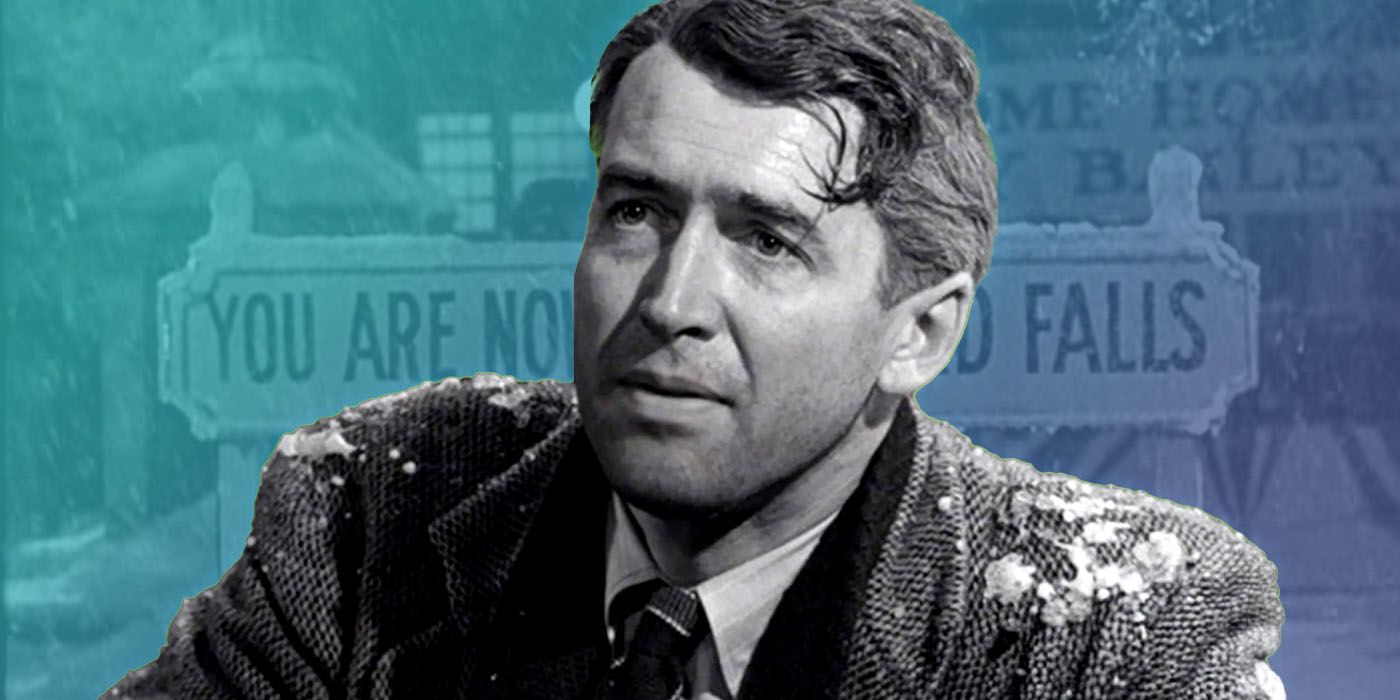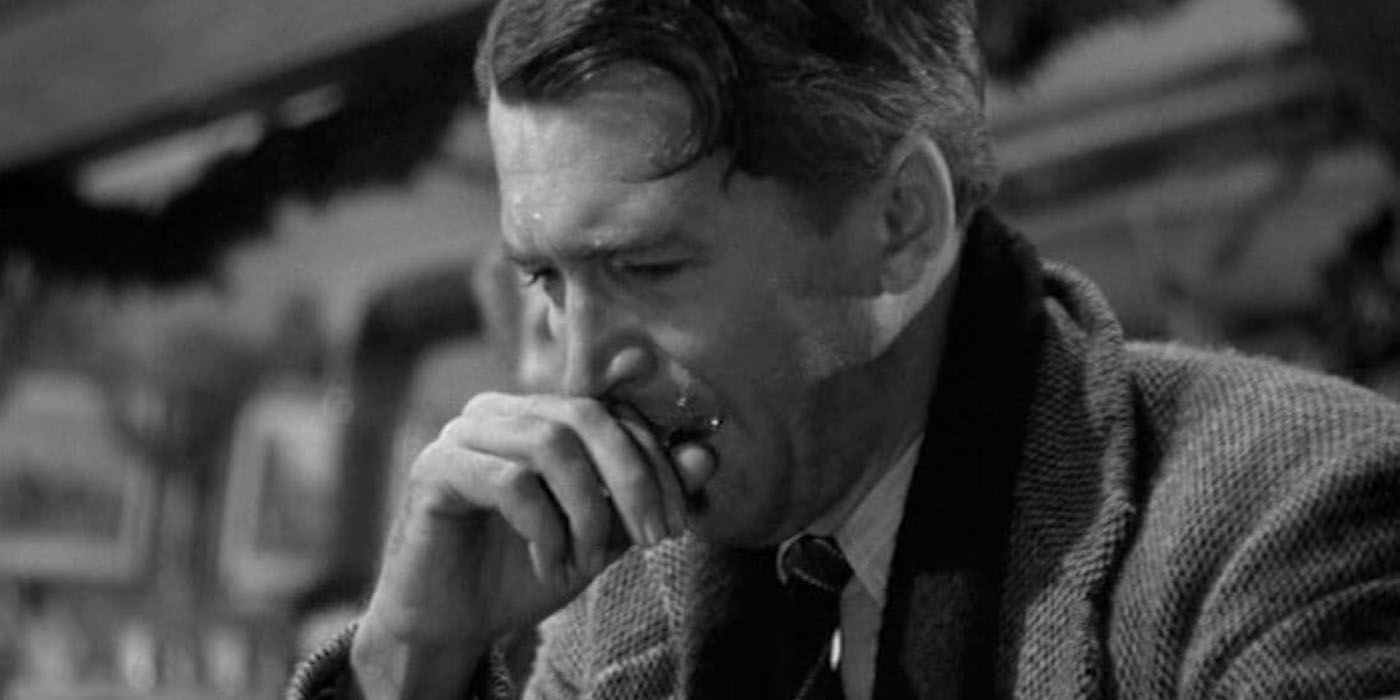The Big Picture
- James Stewart’s real war experiences added depth and authenticity to his performance in It’s a Wonderful Life.
- The film explores feelings of failure and worthlessness, which Stewart himself was grappling with at the time.
- Watching the film Twelve O’Clock High can help provide a deeper understanding of It’s a Wonderful Life and the experiences that influenced Stewart’s performance.
Beloved actor and icon, James Stewart served as a flight leader in World War II and when he returned home, he began working on the 1946 film It’s a Wonderful Life — his first post-war picture. Together with the director, Frank Capra, the two set out to showcase the fictional life of George Bailey in an uplifting movie set during the Christmas period. But with the horrors of war fresh on their minds, they ensured their movie never shied away from man’s darkest tendencies. It may sound counter-intuitive for a movie called It’s a Wonderful Life, but it climaxes with George readying to die by suicide. CNN’s Rachel Scott notes, “Without Stewart’s real acquaintance with darkness, the holiday classic’s redefining perspective on life wouldn’t be able to shine so unforgettably bright.” This doesn’t just refer to the character’s suicidal feelings, however, it relates to James Stewart’s own experiences in the war.
It’s a Wonderful Life begins with the voices of those praying to the heavens: “I owe everything to George Bailey. Help him, dear Father.” Then, the image of space. The voices of angels such as Clarence (Henry Travers) discuss these prayers and recount the life of George Bailey up to this moment of crisis. From his youth, George had ambitions to travel the world but had put others first every time. He remains in Bedford Falls to save his father’s business, to allow his brother to live a fulfilling life, and to protect the home front during air raids. Now, due to the villainy of monopolizing Mr. Potter (Lionel Barrymore), George considers cashing in his life insurance. It’s at this moment that Jimmy Stewart drew from his own life experience in the war and delivered an unscripted moment that made for the movie’s most heartbreaking scene.
It’s a Wonderful Life
An angel is sent from Heaven to help a desperately frustrated businessman by showing him what life would have been like if he had never existed.
- Release Date
- January 7, 1947
- Director
- Frank Capra
- Cast
- James Stewart , Donna Reed , Lionel Barrymore , Thomas Mitchell
- Rating
- PG
- Runtime
- 131
- Genres
- Christmas , Supernatural , Drama
James Stewart’s Real War Experience Drove Him to Tears During the Prayer Scene
Believing himself to be worth more dead than alive, George Bailey prays quietly at a bar after discovering his Uncle Billy has lost an $8,000 deposit and no means to repair the problem. “Dear Father in heaven. I’m not a praying man, but if you’re up there, and you can hear me, show me the way. I’m at the end of my rope,” George cries through tears. In what is a moment that resonates deeply with audiences, it’s a surprise to learn that George wasn’t scripted to cry in this scene, but Jimmy Stewart did. In a 1987 interview, Stewart recalled, “As I said those words, I felt the loneliness, the hopelessness of people who had nowhere to turn, and my eyes filled with tears. I broke down sobbing. This was not planned at all, but the power of that prayer, the realization that our Father in heaven is there to help the hopeless, had reduced me to tears.”
It’s one of the finest pieces of acting anyone has ever done according to actress Carol Burnett, and it draws from Stewart’s own life experience, who had served in the Army Air Corps during the war. Although the character of George never served, the shadow of WWII looms large over It’s a Wonderful Life, with his younger brother Harry (Todd Karns) serving, among others. “It’s a Wonderful Life was a result of Jim’s war experiences because it unlocked this depth of soul in Jimmy,” says biographer Robert Matzen. “He had to learn to act again and that’s what you’re seeing on screen. It’s like lightning that just got captured in a bottle.” When the angel Clarence arrives to answer George’s prayers, an otherwise absurd moment feels earned and celebrated due to the authenticity of Stewart’s performance.
What Does WWII Mean for ‘It’s A Wonderful Life’ and James Stewart?
It’s a Wonderful Life explores the all-too-common feelings of failure and worthlessness, something Jimmy Stewart was grappling with himself at the time, according to Rachel Scott. George Bailey is a man whose entire life has always been in the service of others until one Christmas he hits a breaking point, and it’s up to others to return the favor. Stewart had just won the Academy Award for The Philadelphia Story when he enlisted in the Army in 1941. As a private, he was assigned to the motion pictures unit to document the war from a safer position. However, Stewart, whose family history is rich with military service, fought orders and served overseas.
Stewart was still grappling with the life-or-death pressure of war at the time of shooting It’s a Wonderful Life. “Jimmy Stewart was following his own experience and using that in his character. That is a very hard thing to do,” says TCM’s Ben Mankiewicz. “The audience feels the intensity of that because it was clearly authentic.” The fact that empathy fueled Stewart’s performance shows just how close he was to his character George Bailey during the production. The film also explores the difficult role of supportive wives at the time, which Collider’s Mickey Randle coins “It’s a Wonderful Wife”. In 1954, Stewart would play Glenn Miller in The Glenn Miller Story, the composer whose music largely soundtracked the WWII years and died in Europe in 1944.
‘Twelve O’Clock High’ Is the Key to Fully Understanding ‘It’s A Wonderful Life’
“If you want to understand It’s a Wonderful Life, watch the 1949 20th Century Fox production of Twelve O’Clock High,” James Stewart biographer Robert Matzen insists. The film has been called the most accurate depiction of life in the Eighth Air Force and even became required viewing at U.S. service academies in the 1950s as a result. “The war depicted in Twelve O’Clock High was Jim Stewart’s war,” says Matzen. “Quonset huts, mounting pressure, mud, and boring routine punctuated every so often by terror at 20,000 feet and the sudden death of your roommate.” For this reason, Matzen suggests that Twelve O’Clock High and It’s a Wonderful Life are the perfect double feature, since they depict the world the actor was drawing from when delivering these lines as George Bailey.
Just like the children of the stressed George Bailey in It’s a Wonderful Life, Matzen stresses how “Jim’s kids will tell you the same thing, that the war must have changed him because of that distance, sadness, and occasional blind rage.” The biographer goes on to recall how he can’t help but cringe when Jimmy Stewart first appears in a freeze-frame in It’s a Wonderful Life, intending to represent a young man of only 21. “I squirm because I see an old man and the face of war. A hairpiece and makeup can’t hide the horrors he had just encountered, which is why Twelve O’Clock High should be mandatory viewing for anyone who loves It’s a Wonderful Life. It’s the prequel that tells the story of an actor’s redemption and remarkable return to peacetime.” No wonder the character and the actor are so closely intertwined.
It’s a Wonderful Life is available to rent and buy on Prime Video.
Watch on Prime Video





-feature.jpg)